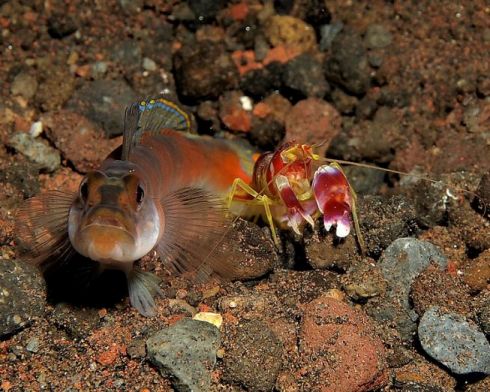
Interactions with other Organisms
Many shrimp in the family Alpheidae have symbiotic relationships with organisms like sponges, cnidarians, echinoderms, molluscs, crustaceans, and gobiid fish (Zeng and Jaafar, 2012). The main relationship that we will focus on is Alpheus randalli’s, along with many other Alpheus species, symbiotic relationships with goby fish. Alpheus randalli and the goby fish both work together in a symbiotic mutualism, meaning both organisms benefit from this relationship.
There are many species of goby fish that form symbiotic
relationships with the Pistol Shrimp, but the Pistol Shrimp are
not selective with which goby species it is. It more depends
on what species are in the area. Some of the species of goby
that form symbiotic relationships include
Myersina macrostoma, Ctenogobiops maculosus
and Psiogobius mainlandi (Zeng and Jafaar 2012). The
first Alpheus randalli was found living with an
Amblyeleotris sp., or more commonly known as an
orange-barred goby (Banner and Banner 1980).
In this relationship, the goby gets the added protection of
having a burrow that the shrimp constructed and the shrimp gets
an organism to watch out for danger while it’s dealing with the
burrow. The pair only comes out of the burrow during the day.
At night the burrow openings are usually blocked or caved in for
protection while both the goby and the shrimp remain inside. The goby is always the first one out and the last
one in at night. Male shrimp spend more time outside of the
burrow than females (Karplus 1999).
The shrimp has very poor eyesight, which makes them dependent
on the goby for seeing the potential dangers. The goby can
differentiate between fish that pose a threat and harmless fish
and will only send warning signals to the shrimp when there is a
threat. A warning signal from the goby is a special tail
flick. The shrimp and the goby usually maintain contact through
the shrimp’s antennae to one of the goby’s fins to ensure the
warning signal is received. There are also differences in the
strength of the warning signal. If it is only a minor threat,
the goby sends the signal, but does not retreat into the
burrow. If it is a larger, immediate threat, like an attack,
the goby quickly dives into the burrow head first with the
shrimp following suit just as fast. This happens so quickly, it
often looks just like a cloud of dust. The shrimp will retreat
into the burrow regardless of the strength of the signal (Karplus
1999).
Another type of interaction that Alpheus sp. shrimp
are involved in is the interaction among each other. If you put two
of these shrimp together living in close association, they will
compete for resources like potential mates and space. Eventually
one will become dominant over the other through a confrontation.
This confrontation usually involves some claw snapping, but is
generally not lethal. This is because the two shrimp fight from a
distance far enough that the force of the snap will not harm the
each other. This type of interaction is more common among males
because they are more aggressive (Masterson 2008).
Now that we know how
Alpheus randalli interacts with other organisms, let's find out
how they reproduce!
